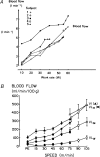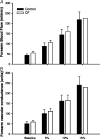Exercise hyperaemia: is anything obligatory but the hyperaemia?
- PMID: 17640934
- PMCID: PMC2277201
- DOI: 10.1113/jphysiol.2007.135889
Exercise hyperaemia: is anything obligatory but the hyperaemia?
Abstract
Exercise can increase skeletal muscle blood flow by 100-fold over values observed at rest. As this value was 3 to 4 times higher than so-called 'textbook' values at the time it raised a number of issues about cardiovascular control. However, there is a continuing inability to identify the factor or combination of factors that explain this substantial increase in muscle blood flow. Moreover, these governing mechanism(s) must also explain the precise matching of muscle blood flow to metabolic demand and oxygen use or need. The difficulties identifying the mechanisms for exercise hyperaemia are especially disappointing due to the essentially concurrent discovery in the 1980s that the vascular endothelium was a key site of vasomotor control and that nitric oxide (NO) potentially released from nerves, endothelial cells, directly from tissues such as skeletal muscle, or perhaps released from red blood cells, might participate in vascular control in a way that would permit blood flow and metabolism to be closely matched.
Figures





Similar articles
-
Neurogenic vasodilation in human skeletal muscle: possible role in contraction-induced hyperaemia.Acta Physiol Scand. 2000 Apr;168(4):481-8. doi: 10.1046/j.1365-201x.2000.00700.x. Acta Physiol Scand. 2000. PMID: 10759585 Review.
-
Exercise hyperaemia: magnitude and aspects on regulation in humans.J Physiol. 2007 Sep 15;583(Pt 3):819-23. doi: 10.1113/jphysiol.2007.136309. Epub 2007 Jul 19. J Physiol. 2007. PMID: 17640931 Free PMC article. Review.
-
Vasodilatory mechanisms in contracting skeletal muscle.J Appl Physiol (1985). 2004 Jul;97(1):393-403. doi: 10.1152/japplphysiol.00179.2004. J Appl Physiol (1985). 2004. PMID: 15220322 Review.
-
Skeletal muscle vasodilatation at the onset of exercise.J Physiol. 2007 Sep 15;583(Pt 3):825-33. doi: 10.1113/jphysiol.2007.135673. Epub 2007 Jul 5. J Physiol. 2007. PMID: 17615103 Free PMC article. Review.
-
The roles of adenosine and related substances in exercise hyperaemia.J Physiol. 2007 Sep 15;583(Pt 3):835-45. doi: 10.1113/jphysiol.2007.136416. Epub 2007 Jul 5. J Physiol. 2007. PMID: 17615100 Free PMC article. Review.
Cited by
-
Blood pressure regulation II: what happens when one system must serve two masters--oxygen delivery and pressure regulation?Eur J Appl Physiol. 2014 Mar;114(3):451-65. doi: 10.1007/s00421-013-2691-y. Epub 2013 Jul 12. Eur J Appl Physiol. 2014. PMID: 23846841 Review.
-
Dynamic response characteristics of hyperaemia in the human calf muscle: effect of exercise intensity and relation to electromyographic activity.Eur J Appl Physiol. 2012 Dec;112(12):3997-4013. doi: 10.1007/s00421-012-2362-4. Epub 2012 Mar 23. Eur J Appl Physiol. 2012. PMID: 22441829
-
Microvascular oxygen pressures in muscles comprised of different fiber types: Impact of dietary nitrate supplementation.Nitric Oxide. 2015 Aug 1;48:38-43. doi: 10.1016/j.niox.2014.09.157. Epub 2014 Oct 2. Nitric Oxide. 2015. PMID: 25280991 Free PMC article.
-
The catecholamines strike back. What NO does not do.Circ J. 2009 Oct;73(10):1783-92. doi: 10.1253/circj.cj-09-0559. Epub 2009 Sep 4. Circ J. 2009. PMID: 19729859 Free PMC article. Review.
-
Muscle fibre-type dependence of neuronal nitric oxide synthase-mediated vascular control in the rat during high speed treadmill running.J Physiol. 2013 Jun 1;591(11):2885-96. doi: 10.1113/jphysiol.2013.251082. Epub 2013 Mar 18. J Physiol. 2013. PMID: 23507879 Free PMC article.
References
-
- Armstrong RB, Laughlin MH. Rat muscle blood flows during high-speed locomotion. J Appl Physiol. 1985;59:1322–1328. - PubMed
-
- Duncker DJ, Oei HH, Hu F, Stubenitsky R, Verdouw PD. Role of KATP+ channels in regulation of systemic, pulmonary, and coronary vasomotor tone in exercising swine. Am J Physiol Heart Circ Physiol. 2001;280:H22–H33. - PubMed
Publication types
MeSH terms
LinkOut - more resources
Full Text Sources
Medical
Research Materials

